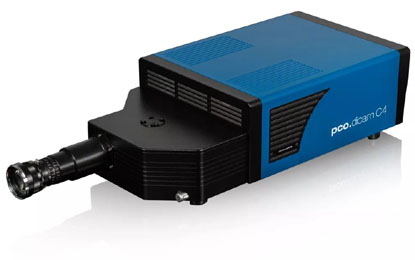論文集錦 I --pco.dicam C1 and C4
PCO 成像技術(shù)
New sCMOS image intensified cameras pco.dicam C1 and C4 set standards in light sensitivity (part I)

When other cameras’ performances hit the wall, the pco.dicam C1 reaches its peak. The newly developed image intensified camera from PCO produces great images even in the weakest low-light conditions and shortest exposure times. This is the result of the unique combination of image intensifier, tandem lens and sCMOS sensor. The pco.dicam C4 goes one step further combining four pco.dicam C1 in one housing.
Using two new developments, PCO meets the demanding needs of users in the fields of science and research. The pco.dicam C1 and pco.dicam C4are cameras with image intensifiers that are suitable for applications with extreme low light conditions. The combination of an image intensifier with an efficient tandem lens and sCMOS sensor is unique among low-light cameras. The cameras can reach over 100 fps at full resolution of 4 MPix and 16 bit dynamic range. The two systems allow imaging with very little light and very short exposure times. A typical application is large particle accelerator research. PCO also uses sCMOS technology in other high performance cameras. For more than 30 years PCO, located in Kelheim Germany, has continued its long tradition of building cameras with image intensifiers that enjoy a high reputation among users.
The pco.dicam C1 has a powerful image intensifier that creates a detailed recording in low light. Its intensifier multiplies the light so that even single photons become visible. When photons hit the photocathode, electrons are struck from the surface. These photoelectrons are sucked by electric field through thin channels of semiconducting material. Inside each channel, the photoelectrons strike more electrons out of the walls, creating an avalanche. After the electron avalanche exits the channel, it strikes a phosphor layer which generates light. Thanks to the intermediate amplification more light exits the phosphor than was incident on the input photocathode. The image on the phosphor layer is imaged with a sCMOS sensor. The many fine channels are 6 μm thin and 0.5 mm long. They are etched in o a glass plate that has a diameter of 25 mm. The complete image intensifier including the input and output windows is 2 cm thick.
To generate even more light with the best possible image quality, thepco.dicam C1 has a tandem lens between the image intensifier and the image sensor. The first lens makes the light rays parallel, the second focuses them back onto the image sensor. This technique achieves light throughput of 30 %, whereas a single lens has only 6 %.
pco.dicam C1: Intensified 16 bit sCMOS camera
The ultimate system is the pco.dicam C4. It combines four pco.dicam C1in one housing. Four image intensifiers, four tandem lenses, four image sensors, everything is 4-fold. There is also another tandem lens with prisms in front of the image intensifiers, which distributes the same image to all the channels. The pco.dicam C4 may not be as compact as many other PCO cameras, however when it comes to light sensitivity and frame rate, it offers the maximum possible today. "It’s a niche market," says Walter Tutsch, sales engineer at PCO. "But the particle physics, e. g. high-energy physics, where exposure times are sometimes just a billionth of a second, require such cameras."

pco.dicam C4: 4-channel intensified sCMOS camera system
Customers who purchase such high-performance cameras make no compromises when it comes to data transmission. Therefore, thepco.dicam C1 and the pco.dicam C4 transmit their data via Camera Link HS. This is a new international communication standard that PCO co-developed and is currently using exclusively. Camera Link HS overcomes the limitations of the 20-year-old Camera Link standard. The latter can only transmit the image data over copper cables up to 5 m long with limited speed. Other communication standards such as USB or Ethernet have disadvantages when connecting to cameras. Camera Link HS, on the other hand, transmits 1,187 MB per second per channel. The number of channels is not limited. The connection is single-mode optical fiber so transmission distance is virtually unlimited. To make good use of this,pco.dicam C1 and pco.dicam C4 can be equipped with remote controls for Canon's EF and EF-S electronic lenses. "Customers are impressed with Camera Link HS," says Walter Tutsch, "and since the licenses are cheap, other camera manufacturers also may soon rely on this standard."
To be continued: Don't miss the interview with Walter Tutsch, sales engineer at PCO, on the highlights of the new pco.dicam C1 and pco.dicam C4 in part II.